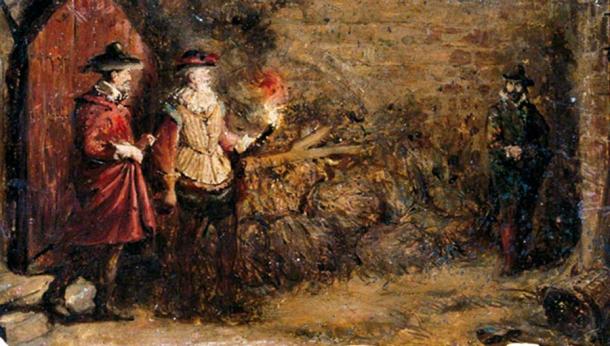🔴 Website 👉 https://u-s-news.com/
Telegram 👉 https://t.me/usnewscom_channel
Every fifth of November, people across the United Kingdom celebrate Guy Fawkes Night (also known as Guy Fawkes Day, Bonfire Night, and Firework Night). Every November, cities and towns across the country put on fireworks displays to commemorate the day which fills the autumn air with a merry atmosphere. Yet, beneath the cheerful façade of the modern celebration of Guy Fawkes Day lies a darker, more sinister history.
Guy Fawkes Day is in fact a celebration of a failed attempt to blow up the British House of Lords in 1605. This attempt is known today as the Gunpowder Plot.
‘Guy Fawkes’ by Charles Gogin, York Art Gallery. (York Museums Trust/Public Domain)
A Reaction to Religious Persecution
The reigning King of England that year was James I, who succeeded Elizabeth I upon her death in 1603. At that time, England was a Protestant country, and Catholics had been persecuted since the reign of Henry VII. These persecutions became more severe during the reign of James’ immediate predecessor, especially after the failed invasion by Catholic Spain in 1588. As James’ wife and mother were both Catholics, it was hoped that the situation for Catholics would improve. Some measures were initially taken to reduce the persecution.
James, however, was pressured by some of his advisors to continue to hound Catholics, as this would placate England’s more extreme Protestants, such as the Puritans. This resulted in a feeling of disappointment and anger, and some Catholics were willing to take extreme measures. As a matter of fact, by the time of the Gunpowder Plot, James had already survived two assassination attempts.
A contemporary engraving of eight of the thirteen conspirators, by Crispijn van de Passe. Fawkes is third from the right. (Public Domain)
Who was the Leader of the Gunpowder Plot?
The leader of the Gunpowder Plot was Robert Catesby, a wealthy gentleman from Warwickshire. In May 1604, Catesby met with four other Catholics, Guy Fawkes, Thomas Wintour, John Wright, and Thomas Percy in London to discuss their plan. Although Parliament was to be adjourned in February 1605, it was postponed to October 3, due to concerns over the bubonic plague in London. This gave the conspirators more time to finalize their plan.
The plan was this: Blow up the House of Lords, lead a revolt in the Midlands, kidnap the nine-year-old Princess Elizabeth, and install her as a Catholic head of state. For this plan to succeed, Catesby was required to bring more men into the conspiracy. By the time of the Gunpowder Plot’s attempt, the enterprise consisted of 13 conspirators.
Yet, it was also this necessity that contributed to the Gunpowder Plot’s undoing. The more people who know about a plot, the more likely it will leak. On October 26, 1605, an anonymous letter was sent to William Parker, 4th Baron Monteagle, warning him against attending parliament for the opening and hinting at the plot. The popular belief is that the letter was written by Francis Tresham, Monteagle’s brother-in-law and a late recruit to the plot. Uncertain about the letter’s meaning, Monteagle sent it to the Secretary of State, Robert Cecil.
Guy Fawkes was Found with the Gunpowder
On the fourth of November, buildings in and around the Houses of Parliament were searched, leading to the discovery of Guy Fawkes and 36 barrels of gunpowder in the undercroft beneath the House of Lords. Incidentally, after the gunpowder was seized, it was found to have had decayed, i.e., separated into its component parts after being left for too long, thus rendering it harmless.
Had the English Parliament adjourned in October as planned (it was postponed to November due to the lingering plague in the capital), the Gunpowder Plot might have worked.
Painting showing the arrest of Guy Fawkes by the Royalist soldier Sir Thomas Knevet; Guy Fawkes (1570-1606) had been attempting to blow up the Houses of Parliament in the attack in 1605. Light gleams on the armour and rich clothing of Sir Thomas Knevet; On the left, a concealed lantern throws subdued light on one of Guy Fawkes’ men, lighting his face from below. (1823). (Public Domain)
Despite the plot’s failure, it may be argued that it came quite close to fruition, leading some to suspect that the conspirators were aided by certain members of the English government. Nevertheless, this remains an unproven theory.
The Gunpowder Plot’s Legacy
If the Gunpowder Plot had indeed succeeded, the course of English history would have been altered quite drastically. One possible outcome might have been the strengthening of Protestantism in England, with English Catholicism persecuted more harshly. On the other hand, it might also have been possible that a Catholic monarch could have been placed on the throne, and England eventually transformed into a Catholic dominated state.
Despite these speculations, English history took the path we all know today, and the significance of the failed plot for many today is more or less reduced to the annual bonfires and fireworks displays put on across the country.
Top Image: “The Gunpowder Plot: The conspirators’ last stand at Holbeach House” by Ernest Crofts. Source: Public Domain
By Ḏḥwty
Updated on November 5, 2024.



